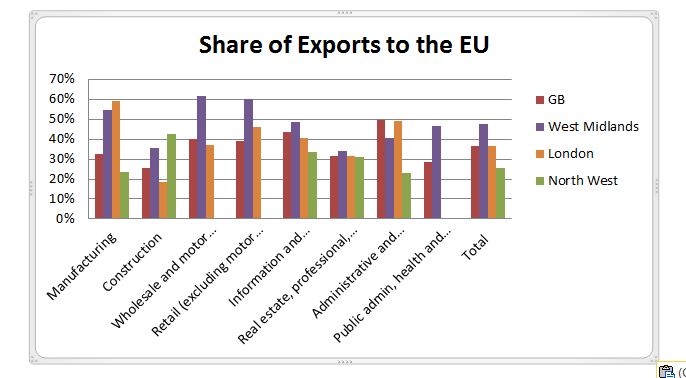
On July 11, the ONS has released its estimates of regional Service exports for GB regions. The release is here – https://goo.gl/4d7Kjx
Doing one of my favourite things and turning absolute figures to percentages, a number of interesting insights come up. Below, the commentary focuses only on Manufacturing; Wholesale and Motor Trades; Information and Communication; and Real Estate, Professional, Scientific and Technical sectors. These sectors are 90% of the West Midlands service exports and 87% of the GB service exports.
| Service Exports to EU | |||||
| Region | Manufacturing | Wholesale and motor trades | Information and communication | Real estate, professional, scientific and technical | Total |
| GB | 33% | 40% | 43% | 31% | 37% |
| West Midlands | 55% | 62% | 49% | 34% | 47% |
| East Midlands | 52% | 55% | 49% | 29% | 37% |
| London | 59% | 37% | 40% | 32% | 37% |
| North East | 61% | 87% | 42% | 21% | 49% |
| North West | 23% | – | 34% | 31% | 26% |
| Yorkshire and the Humber | 34% | 57% | 43% | 42% | 40% |
| South East | 29% | 81% | 53% | 35% | 45% |
| South West | 28% | – | 50% | 31% | 32% |
| East | 42% | 57% | 30% | 27% | 33% |
| Wales | 33% | 67% | 49% | 27% | 35% |
| Scotland | 23% | 56% | 38% | 25% | 26% |
The table shows clearly the tight economic relationship between GB and its regions on the one hand and the EU on the other. However the strength of this relationship (as demonstrated by the share of service exports directed to the EU) varies. For example 26% of service exports for Scotland and the North West go to the EU whilst this is almost double for the North East and West Midlands regions.
With regards to the latter, 55% of the West Midlands’ £934m exports in manufacturing services; 49% of its £759m in Information and Communications; 34% of its £693m of exports in Real Estate, Professional, Scientific and Technical Services; and 62% of its £177m exports in Wholesale and Motor Trades’ services head for the EU.
The differences between these percentages and the percentages of other regions (i.e. manufacturing services to the EU range from 61% in North East to 23% in North West!) show that the impact of the Brexit deal to be achieved in trade will have a very distinct spatial footprint instead of a homogenous effect.
These impacts need to be carefully calculated and (if realised) they should be compensated by multiplying any efforts to increase exports to non-EU countries.
To sign up to our blog mailing list, please click here

1 thought on “West Midlands’ Service exports to the EU: Brexit will not be the same for every region”